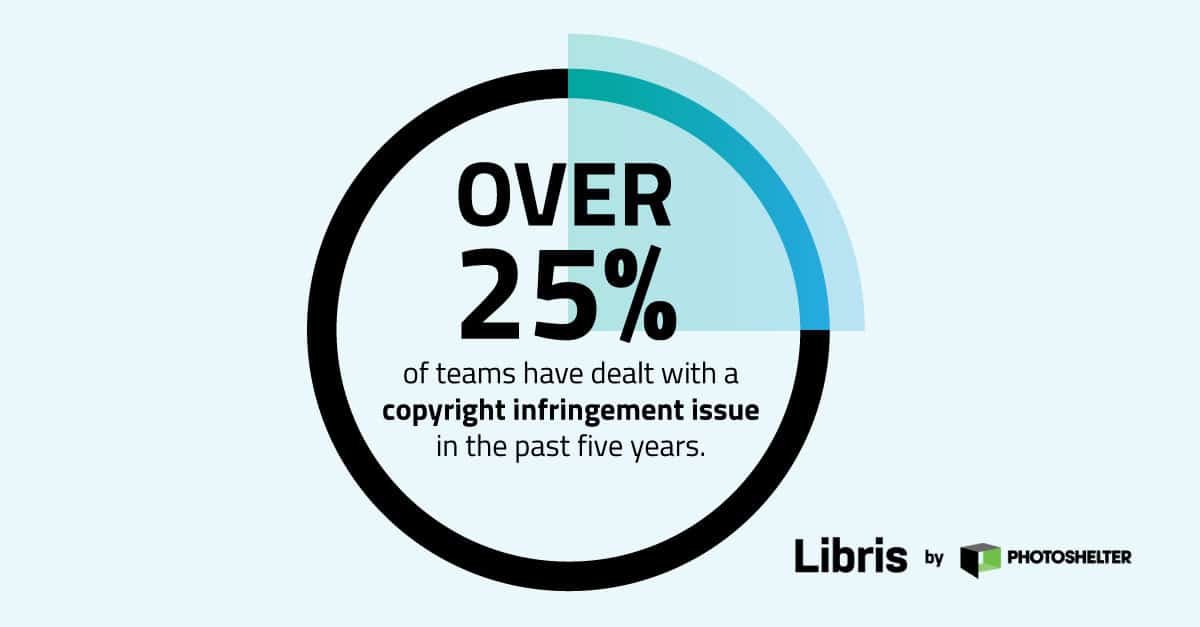If you’re managing visual content for your brand, it’s important to have a solid hold on all your usage rights. For example, do you know exactly where you’re allowed to distribute photos you sourced from a freelance photographer? And for how long?
In a recent PhotoShelter survey, we learned that marketers are often out of the loop on copyright and over 25% of teams have dealt with a copyright infringement issue in the past five years.
According to U.S. Copyright Law, a court may award a copyright holder of a timely-registered U.S. copyright statutory damages of up to $150,000 per image for willful infringement made by a person or organization. That’s a lot of money — and a lot of risk.
The first step to staying out of hot water is to understand the ins and outs of copyright itself. What does copyright mean exactly? What is Fair Use? Is the Digital Millennium Copyright Act something you need to know about?
Here are 10 copyright definitions you should always have in your back pocket. For more terms, download the complete Copyright 101: A Glossary for Marketers.
Copyright
Copyright applies to both published and unpublished works, and is attached to the original work as soon as it is created. Copyright is a form of protection under Copyright Law for original works of authorship, including photos, videos, graphics, illustrations, audio and more. Copyright grants what is referred to as a “limited monopoly” on the work created, which gives creators the ability to profit from the fruits of their labor. Copyright information can be embedded directly into a photo through IPTC Metadata. (Source: U.S. Copyright Office)
Copyright Infringement
Copyright infringement occurs when a copyrighted work is reproduced, distributed, performed, publicly displayed, or made into a derivative work without the permission of the copyright owner or their authorized licensor. A copyright holder can request actual or statutory damages if infringement occurs. However, for statutory damages to apply the work must have been timely registered and the court advised as to which form of damages are sought. (Source: U.S. Copyright Office)
Copyright Management Information
Copyright management information (CMI) is a phrase used and defined in the Digital Millennium Copyright Act. Generally, CMI is the visible watermark or the digital information stored as metadata on the image. Removal or alteration of CMI is actionable under the DMCA. (Source: U.S. Code)
Copyright Registration
Copyright is an automatic right and does not require the creator (for example, the photographer) to file with the United State Copyright Office. According to U.S. Copyright Law, photographers who do register their copyright have the ability to request statutory damages and not rely solely on actual damages. This means a copyright holder can request the court to award statutory damages, which can be up to $150,000 per image for willful infringement made by a person or organization. Non-willful infringement claims have a maximum award for statutory damages of $30,000. (Source: U.S. Copyright Office)
Copyright Symbol
The “circle c” symbol – © – can be applied to a work regardless of registration. Though U.S. copyright law no longer requires the inclusion of the copyright symbol, it is a visual indicator that the owner is claiming copyright in the work. If the copyright symbol is present, removal or alteration of the symbol and the associated information is unlawful. (Source: U.S. Copyright Office)
Derivative Work
A derivative work is a new work that was created from one or more already existing works. Only the owner of a copyrighted work has the authority to create a derivative work. Editing a photo, adding filters, and creating a composite image from multiple images are all forms of derivative works, as are creating lithographs or hand-drawings from a photo. Derivative works can obtain their own copyright, but only with regard to the new material and upon registration must disclose the ancestry of the existing material. (Source: U.S. Copyright Office)
Fair Use
Fair Use is an exception to copyright infringement and legally permits the unauthorized use of copyright-protected works in certain circumstances—such as criticism, comment, news reporting, teaching, scholarship, and research. Noncommercial use of photos, videos, etc. is more likely to be deemed Fair Use than commercial use, though the debate is ongoing. (Source: Harvard University)
The Digital Millennium Copyright Act
The Digital Millennium Copyright Act (DMCA) includes Safe Harbor provisions, making it possible for online social sharing services to exist without being held liable as a “secondary copyright infringer” should a user of the service post a copyrighted work not his own, and for which there is no Fair Use exception, and the author wants it removed. The DMCA created a protocol for officially asking that copyrighted images be removed from a site, commonly known as a “takedown notice.” (Source: Harvard University)
Watermark
A watermark is a logo, brand mark, or other visible identification mark superimposed on or impressed into an image, film, or video clip, or on paper. Digital versions of watermarks identify the source of an image or provide additional information about the image. They can be both visible and undetectable to the human eye. (Source: Picture for Licensing Glossary)

Work Made for Hire
Work Made for Hire is a work prepared by an employee within the scope of his or her employment or a work specially ordered or commissioned for one of the enumerated uses. If a work is made for hire, an employer is considered the author and copyright holder even if an employee actually created the work. The employer can be a firm, an organization, or an individual. There must be a written agreement signed by the parties stating the work is to be considered a work made for hire. (Source: U.S. Copyright Office)
For more important definitions and copyright resources, check out Copyright 101: A Glossary for Marketers.





